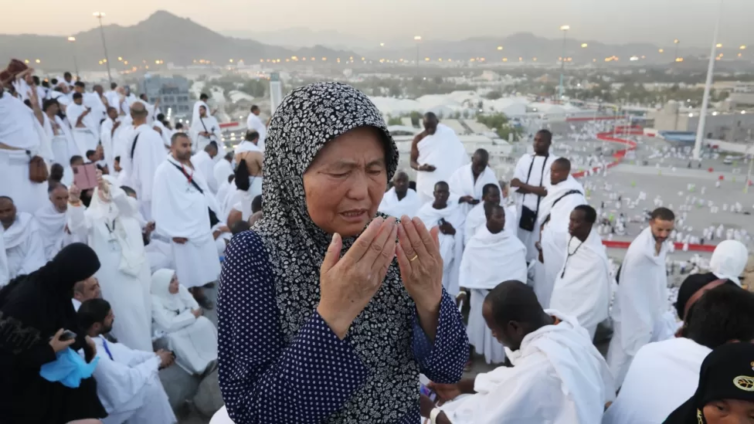Some 1.8 million Muslims from across the world made it to Mount Arafat in Saudi Arabia on Tuesday to mark the most important day of the Hajj.
But due to global price rises, the pilgrimage is becoming increasingly unaffordable.
"The number of bookings has significantly dropped this year. It's too costly for many people," says an employee at a private Egyptian tour operator in charge of organising Hajj trips, who wanted to remain anonymous out of fear of a backlash over their criticism of their country's economic situation.
In Egypt, the most populous Arab country, the cheapest government-sponsored pilgrimage currently costs around $6,000 (£4,720) - double what it was last year.
The price hike has been fuelled by the sharp devaluation of the Egyptian pound, which has lost more than 50% of its value against the US dollar since March 2022. As a result, the cost of living has also skyrocketed, with annual core inflation hitting 40% in May.
About 30% of the population was living below the government's poverty line before the Covid-19 pandemic, and the World Bank says the figure is likely to have risen since then.

'My dream'
Farida, a retired Egyptian civil servant, saved to go on the Hajj for five years.
"All my savings are not enough to pay for the trip. When I saw the price list, I was shocked," she says.
Farida - not her real name - is a widow and mother of five. She also asked not to be identified because she did not want to publicly criticise Egyptian authorities over the rising cost of living.
Farida says that performing the Hajj is "my dream", adding: "Hajj cleanses the soul."
She says her children are all married, so "social and financial responsibilities have been lifted off my shoulders".
"It is about time to go to Hajj."
Farida has already been to Mecca four times before to perform the lesser Umrah pilgrimage, which includes some of the rituals of the Hajj and can be undertaken at any time of the year.
This time, she used a loophole in the system so that she could perform the Hajj.
"Instead of the Hajj visa, I got a three-month-tourist visa and arrived in Mecca a month before the Hajj season kicks off," she tells me from Saudi Arabia while waiting to start the pilgrimage. "This is the only option I have got."
Farida's whole trip to Mecca works out 80% cheaper than the government-sponsored Hajj package.

Subsidy cuts
Hajj is one of the five pillars of Islam. Muslims are required to make the journey to Mecca at least once in their lifetime if they are physically and financially capable of doing so.
The pilgrimage starts on the eighth day of the Islamic lunar month of Dhul Hijjah, which this year corresponded to 26 June in the Gregorian calendar, and lasts five to six says.
The Hajj usually attracts between 1.5 million and 2 million pilgrims, but this is the first time since the pandemic that Saudi authorities have allowed it to return to full capacity.
Saudi Arabia allocates each country an annual quota based on the number of Muslims living there.
The biggest goes to Indonesia - the world's largest Muslim-majority nation, with a population of 270 million. It was given 221,000 places this year.
Indonesian authorities decided this year to cut the subsidy for the pilgrimage to 50% from 60%, meaning that each Indonesian pilgrim had to pay $3,320. In 2022, the package cost $2,660.

Political barriers
While the financial cost can prove an obstacle for many Muslims around the world, for those in Yemen - Saudi Arabia's war-torn and impoverished southern neighbour - the situation is far more complicated.
The country has been devastated by a conflict that escalated in 2015, when a Saudi-led military coalition intervened after the Iran-backed rebel Houthi movement seized control of large parts of the country. The fighting has reportedly killed more than 150,000 people and caused one of the world's biggest humanitarian disasters.
This month, Yemeni pilgrims flew directly from the rebel-held capital, Sanaa, to Saudi Arabia for the Hajj - the first such commercial flights in about seven years.
Those who travelled had to pay about $3,000 - a considerable sum in a country where more than 21 million out of a population of 30 million people need some kind of humanitarian assistance and 17 million do not know where their next meal will come from.
"In 2016, I went to Hajj for less than half of this price. It's too expensive for me now," one Yemeni journalist says.
Latest Stories
-
NSMQ star Jochebed Adwoa Sutherland sweeps 12 awards at UG Vice-Chancellor’s Ceremony
31 mins -
Ghana’s Education Quality ranked 125 out of 183 countries in latest Global Youth Development Index
56 mins -
Emma Stone wants people to use her real first name
59 mins -
FIFA Club World Cup 2025: Sundowns, Esperance join Al Ahly and Wydad as CAF representatives
5 hours -
CAFCL: Al Ahly set up historic final with ES Tunis
5 hours -
We didn’t sneak out 10 BVDs; they were auctioned as obsolete equipment – EC
9 hours -
King Charles to resume public duties after progress in cancer treatment
10 hours -
Arda Guler scores on first start in La Liga as Madrid beat Real Sociedad
10 hours -
Fatawu Issahaku’s Leicester City secures Premier League promotion after Leeds defeat
10 hours -
Anticipation builds as Junior Speller hosts nationwide auditions
10 hours -
Etse Sikanku: The driver’s mate conundrum
11 hours -
IMF Deputy Chief worried large chunk of Eurobonds is used to service debt
11 hours -
Otumfuo Osei Tutu II celebrates 25 years of peaceful rule on golden stool
11 hours -
We have enough funds to pay accruing benefits; we’ve never missed pension payments since 1991 – SSNIT
12 hours -
Let’s embrace shared vision and propel National Banking College – First Deputy Governor
12 hours

